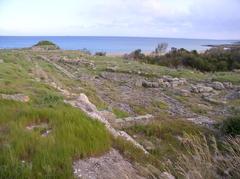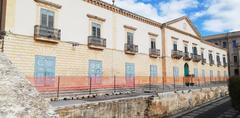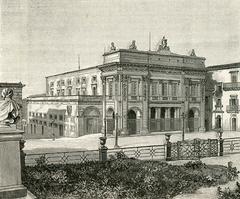Villa Romana del Tellaro: Visiting Hours, Tickets, and Noto Historical Sites Guide
Date: 15/06/2025
Introduction
Nestled in the scenic southeastern Sicilian countryside near Noto, the Villa Romana del Tellaro stands as a magnificent testament to late Roman luxury and artistry. Dating from the 4th century CE, the villa is celebrated for its exceptionally preserved mosaics and grand architectural remains, offering a rare window into the social, artistic, and economic life of late antique Sicily. Discovered in 1971 beneath a 17th-century farmhouse, its mosaics vividly illustrate mythological scenes, dynamic hunts, and geometric motifs—evidence of North African craftsmanship and the cosmopolitan influences of the era (Villa Romana del Tellaro Official Tourism; Hermes Sicily Guide).
The villa’s location, just south of Noto’s UNESCO-listed Baroque center and near the Vendicari Nature Reserve, makes it an ideal destination for history enthusiasts, art lovers, and travelers seeking to immerse themselves in authentic Sicilian heritage (Great Sicily; Tourist Secrets). This guide provides all the essential information—visiting hours, ticketing, accessibility, site highlights, and travel tips—to help you plan a memorable visit.
Table of Contents
- Introduction
- Practical Visitor Information
- The Villa: History, Layout, and Mosaics
- Plan Your Visit
- Frequently Asked Questions (FAQ)
- Visual Highlights
- Conclusion and Call to Action
- References and Official Sources
Practical Visitor Information
Visiting Hours
- April to September: Tuesday–Sunday, 9:00 AM – 7:00 PM
- October to March: Tuesday–Sunday, 9:00 AM – 5:00 PM
- Closed Mondays (open on public holidays; hours may vary)
Check the official website before your visit for any seasonal or extraordinary changes.
Tickets and Admission
- Standard adult: €6
- Reduced (EU citizens 18–25): €3
- Free: Under 18, EU teachers, and certain other categories (bring ID)
- Purchase: On-site or via official online platforms. Advance booking recommended during peak seasons and for guided tours.
Getting There
By Car:
The villa lies about 8–10 km south of Noto, easily reached via the SP19 road toward Pachino. Free parking is available at the site, and signage is clear from the main routes (Vieni in Sicilia).
By Public Transport:
Public transport is limited—no direct bus routes. The nearest train station is in Noto; taxis or organized tours with transfers are the best options from there.
Accessibility and Visitor Services
- Partial wheelchair accessibility: Main entrance and some viewing platforms are adapted, but uneven ancient surfaces may limit access in certain areas.
- Facilities: Modern restrooms, a small bookshop with guidebooks and souvenirs, and multilingual information panels in Italian and English.
- Guided tours: Available by reservation (Italian and sometimes English); audio guides and printed brochures enhance self-guided visits.
The Villa: History, Layout, and Mosaics
Discovery and Archaeological Significance
The villa was uncovered in 1971 beneath a 17th-century farmhouse, which inadvertently helped preserve its remarkable mosaics. Archaeologists revealed a sprawling complex—about 6,000 square meters—centered on a large peristyle courtyard and surrounded by residential and service rooms (Italia Italy).
Architectural Features
- Peristyle Courtyard: The heart of the villa, highlighted by restored columns and intricate mosaic floors.
- North Portico: Houses the most elaborate mosaics, opening onto main residential spaces.
- Thermal Baths and Hypogeum: Remnants of private baths and underground service areas can be seen on guided tours (Hermes Sicily Guide).
- Integration with Masseria: The later farmhouse structure shelters the mosaics and serves as a visitor center.
Mosaic Highlights
Executed in opus tessellatum, the mosaics use vibrant tesserae of stone and glass. Notable panels include:
- The Hunting Scene: A lively depiction of aristocratic hunts with exotic animals, framed by geometric and animal motifs (Hermes Sicily Guide).
- The Ransom of Hector: A mythological scene from the Iliad, illustrating King Priam and Achilles (Vieni in Sicilia).
- Portico Carpet: An ornate mosaic spanning the north portico, with laurel garlands, octagons, and floral medallions (Un Viaggio Infinite Emozioni).
- Bacchic and Festive Motifs: Panels depicting Dionysian revels and fruit-laden vases.
- Geometric and Animal Patterns: Interlacing garlands, stylized leaves, and animal figures throughout.
Conservation Efforts
The mosaics were conserved in situ after excavation, with restoration work ensuring their preservation. The farmhouse roof and modern walkways protect the fragile artwork, while fire damage from the villa’s late antique history remains visible—testament to its dramatic past (Un Viaggio Infinite Emozioni).
Plan Your Visit
Best Times to Visit
- Spring and autumn: Ideal for mild weather and fewer crowds. The Infiorata di Noto (flower festival) in May is a highlight.
- Summer: Hot and busier—visit early or late in the day.
- Winter: Tranquil and mild, with possible reduced hours.
Guided Tours and Interpretation
Guided tours last 60–90 minutes and are highly recommended for historical context and mosaic interpretation. Audio guides and brochures are also available (Great Sicily).
Visitor Tips
- Book tickets and tours in advance during peak times.
- Wear comfortable shoes and bring water/sun protection.
- Allocate 1–1.5 hours for your visit.
- Photography without flash is allowed.
- Respect barriers and avoid touching the mosaics.
Nearby Attractions
- Noto’s Baroque city center: UNESCO World Heritage Site.
- Vendicari Nature Reserve: Birdwatching and beautiful beaches.
- Calamosche Beach: A pristine spot for relaxation.
- Local dining: Enjoy Sicilian specialities in Noto’s trattorias.
Frequently Asked Questions (FAQ)
Q: What are the opening hours?
A: Tuesday–Sunday, 9:00 AM – 7:00 PM (summer); 9:00 AM – 5:00 PM (winter); closed Mondays. Check for updates (official site).
Q: How much are tickets?
A: Standard adult €6; reduced €3; free for under 18s, EU teachers, and more. Bring ID.
Q: Is the site accessible for wheelchair users?
A: The main areas are partially accessible; some uneven surfaces remain.
Q: Are guided tours available?
A: Yes, in Italian and sometimes English; reserve in advance.
Q: Can I take photographs?
A: Photography without flash is permitted.
Q: Is there parking?
A: Free parking is available adjacent to the site.
Visual Highlights
Alt text: Mosaic depicting an aristocratic hunting scene with exotic animals at Villa Romana del Tellaro.
Alt text: Restored columns and mosaic floors in the peristyle courtyard.
Alt text: Annotated map showing the layout and main rooms of Villa Romana del Tellaro.
Conclusion and Call to Action
Villa Romana del Tellaro is a jewel of Roman Sicily, offering a vivid encounter with the island’s ancient heritage through its mosaics and evocative architecture. Planning your visit with current information on opening hours, tickets, and accessibility ensures a smooth and enriching experience. Pair your tour with Noto’s Baroque wonders and the nature of Vendicari for a memorable day in southeastern Sicily.
For up-to-date visitor details, guided tours, and exclusive content, download the Audiala app and follow our social media channels. Explore related articles on Roman villas, Sicilian culture, and Noto historical sites to make the most of your journey!
References and Official Sources
- Villa Romana del Tellaro Official Tourism
- Hermes Sicily Guide
- Great Sicily
- Tourist Secrets
- Italia Italy
- Vieni in Sicilia




